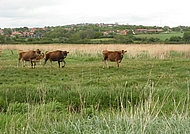SP 3 - Ecosystem functions and services provided by vegetation
SP 3 will link changes in abiotic conditions (water and nutrient supply, land use) with changes in vegetation-based ecosystem functions and services. SP 3 assumes that responses of plants to changes of climate and land use depend on their functional traits rather than on their taxonomic affiliation. Through shifts in plant functional trait composition, changes in species composition lead to changes in ecosystem functions and services. Our specific objectives are:
- To understand responses of plant traits to environmental changes and their effect on ecosystem functions.
- To assess the use of plant traits as indicators for ecosystem services
- To asses consistency of environment – vegetation – ecosystem relationships on broad regional scales.
- To understand trade-offs between ecosystem services based on the interactions between functional groups.
From 160 plots distributed in The Netherlands, Denmark, Northwest- and Northeast-Germany, four datasets will be produced:
- biomass removal through land use, bi-weekly groundwater levels, soil carbon pools, soil nutrient pools, sedimentation rates,
- plant species abundances;
- plant traits indicating the above-mentioned ecosystem properties;
- ecosystem properties provided by the vegetation (net primary productivity, peak standing biomass, litter decomposition).
Changes in water and nutrient regimes and land use as envisaged in COMTESS can have direct repercussions on ecosystem functions and services (e.g. switching between carbon sinks to sources). We will determine the response of measured indicators of ecosystem functions and services to hydrological conditions and land management at the North and Baltic Sea using predictive statistical regression techniques.
However, changes in water regimes and land management also cause changes in habitat suitability which may lead to declining species populations. Saltwater floods may even extinguish species sensitive to salt. Through shifts in plant functional trait composition, changes in species composition can lead to changes in ecosystem functions and services. For instance, stem traits of coastal plants display a strong response to soil nutrients and a strong effect on productivity, whereas seed traits respond strongly to disturbance and nutrients but do not affect productivity. WP3 will apply a trait-based “response and effect” framework to statistically link the abiotic environment, biodiversity and ecosystem functions and services via plant traits as functional indicators. Apart from the direct link from environmental conditions to ecosystem functions, this link represents an alternative, indirect biodiversity – mediated path to ecosystem functions and services. The relative strength of path A and B will be explored and quantified with modern path analysis for all environmental and ecosystem variables quantified on the 160 plots.
We will quantify the relative contribution of the direct environment - ecosystem functioning path (A) and of the plant trait-based response-effect paths (B).
Understanding the resilience of coastal ecosystems to increasingly stochastic hydrological conditions is a cornerstone of COMTESS. However, extreme hydrological conditions may not occur naturally in the field during the funding period. We therefore perform a lysimeter experiment to simulate the effect of extreme conditions on the vegetation. Reed communities will be subjected to intermediate and excess supply of brackish water as well as drought for different time period. How plants would attenuate waves can also be a critical question during stochastic events such as storm surges. In order to figure out which plant traits would contribute most in wave attenuation, floods will be simulated in form of a wave flume experiment.
Since plants play an important role in greenhouse gas fluxes, a lab experiment will be performed to identify which plant traits determine the production of methane and carbon dioxide and to understand the effect of them in combination with soil-properties.
Another objective will focus on the assessment of reed (Phragmites australis) for energy production or industrial use by performing combustion experiments.








